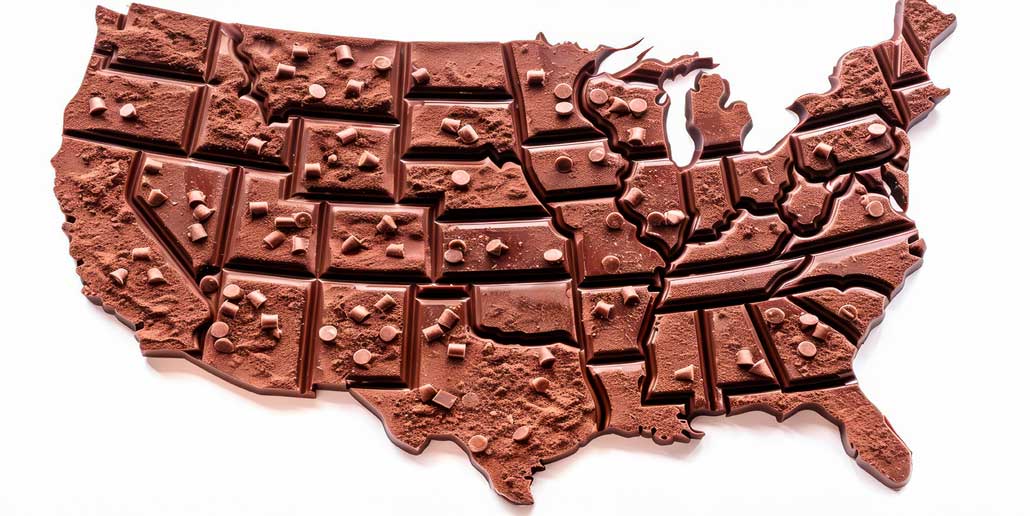
North America’s Love Affair with Chocolate
In North America, chocolate is more than a sweet treat — it’s woven into childhood memories, festive traditions, and moments of indulgence. From the first mass-produced candy bars to the rise of award-winning craft chocolatiers, the story of North America’s chocolate culture is one of bold innovation, cultural fusion, and a growing return to cacao’s ancient roots.
Today, we explore how North America’s chocolate traditions have evolved, from factory floors to artisanal workshops — and why this love affair is stronger than ever.
The Rise of Mass-Produced Chocolate: Hershey’s, Mars, and the Democratization of Sweetness
The late 19th and early 20th centuries marked a turning point in chocolate history. Until then, chocolate was largely a luxury good, enjoyed primarily by the wealthy. But visionaries like Milton Hershey and Frank C. Mars changed that forever.
Milton Hershey pioneered the mass production of milk chocolate with the founding of The Hershey Company in 1894. Hershey’s use of fresh milk and affordable pricing made chocolate accessible to everyday Americans, not just the elite. Iconic creations like the Hershey’s Milk Chocolate Bar (1900) and Hershey’s Kisses (1907) quickly became household staples.
Meanwhile, Frank C. Mars founded Mars, Incorporated, introducing candy bars that combined chocolate with nougat, caramel, and peanuts. The Milky Way (1923) and Snickers (1930) revolutionized candy aisles, offering portable, filling treats during an era of industrial growth and economic hardship.
Mass production not only democratized chocolate consumption but also ingrained it into North America’s chocolate culture, from Halloween trick-or-treating to Valentine’s Day traditions. Chocolate became a symbol of comfort, reward, and celebration, available to anyone.
The Bean-to-Bar Movement and Artisan Revival
While mass-produced chocolate dominated much of the 20th century, a quiet revolution was brewing. By the early 2000s, a new wave of chocolatiers began to question the industrialized approach to chocolate. Where did the cacao beans come from? How were they grown? How did processing impact flavour?
This gave rise to the bean-to-bar movement — a return to craftsmanship where chocolatiers controlled the entire chocolate-making process, from sourcing cacao beans directly from farmers to roasting, grinding, and molding chocolate themselves.
Pioneering artisan brands like TCHO (San Francisco), Mast Brothers (New York), Dandelion Chocolate (California), and Raaka Chocolate (Brooklyn) emphasized ethical sourcing, transparent production, and small-batch quality. These craft chocolatiers celebrated the unique flavors of different cacao origins — fruity, nutty, floral, or spicy — without relying on heavy milk or sugar to mask them.
Today, North America is home to hundreds of bean-to-bar makers pushing boundaries in flavor and technique. The movement has also encouraged a deeper consumer appreciation for cacao as an agricultural product, much like wine or coffee.
Mexican Chocolate: An Ancient and Modern Staple
No exploration of North American chocolate would be complete without paying homage to Mexico, the birthplace of cacao civilization.
For the Maya and Aztec peoples, cacao wasn’t just food — it was sacred. It played a central role in rituals, economy, and even mythological creation stories. Traditionally, cacao was ground into a paste and prepared as a bitter, frothy drink mixed with water, spices, and sometimes chili.
Today, Mexican chocolate still reflects these ancient roots. Table chocolate — often sold in disks or tablets — is coarse, rustic, and infused with cinnamon and other spices. It’s typically used to make hot chocolate (champurrado) or incorporated into savory dishes like mole sauce, a rich, complex sauce blending chocolate, chili peppers, nuts, and spices.
Brands like Ibarra and Abuelita are household names in Mexico and among Mexican-American communities, preserving traditional flavors while new artisanal chocolatiers reimagine ancient recipes with single-origin cacao and contemporary twists.
Mexico’s deep connection to cacao reminds us that chocolate’s story in North America is much older than Hershey’s or Mars — it’s a story rooted in ceremony, community, and centuries of agricultural expertise.
Iconic North American Chocolate Creations
Beyond mass production and artisanal craft, North America has given the world some truly iconic chocolate creations that define generations:
- S’mores: A campfire classic of graham crackers, marshmallows, and melted chocolate, first popularized by the Girl Scouts in the 1920s.
- Chocolate Chip Cookies: Invented by Ruth Wakefield at the Toll House Inn in Massachusetts during the 1930s, these beloved cookies revolutionized home baking.
- Rocky Road Ice Cream: A post-Great Depression treat combining chocolate ice cream, marshmallows, and nuts to lift spirits during hard times.
- Peanut Butter Cups: H.B. Reese’s brilliant pairing of chocolate and peanut butter has become one of North America’s most enduring flavor combinations.
- Chocolate Fudge: Sweet, dense, and indulgent, fudge is a North American invention that became a vacation town and county fair favorite.
Each creation reflects North America’s tendency to innovate with chocolate, blending it into new contexts and combinations that resonate with local tastes and traditions.
North America’s love affair with chocolate is a tale of transformation — from mass-market innovation to craft revival, and from ancient rituals to modern indulgences. Whether you prefer a classic Hershey’s Kiss or a single-origin 70% dark bar, chocolate continues to capture hearts, one bite at a time.

